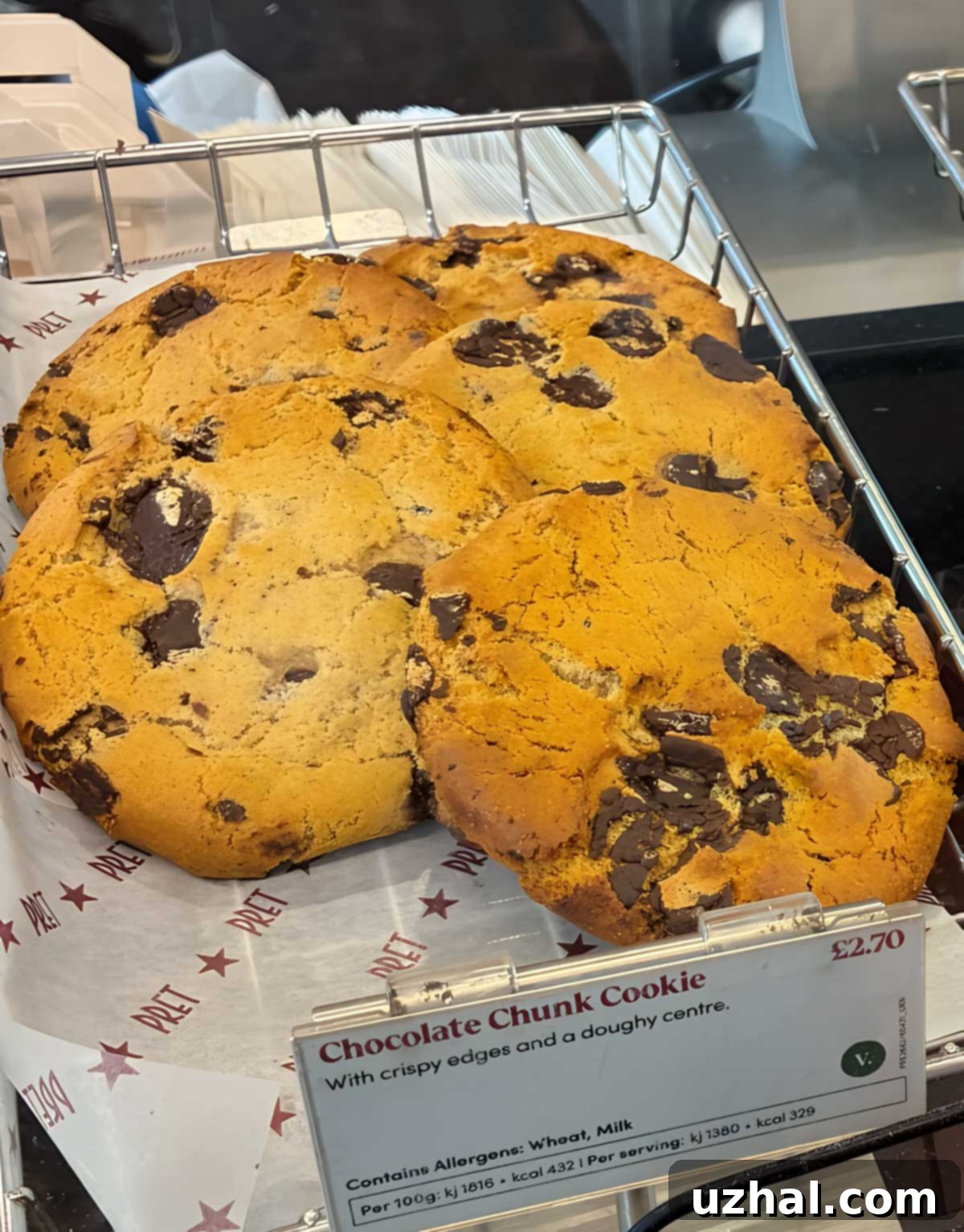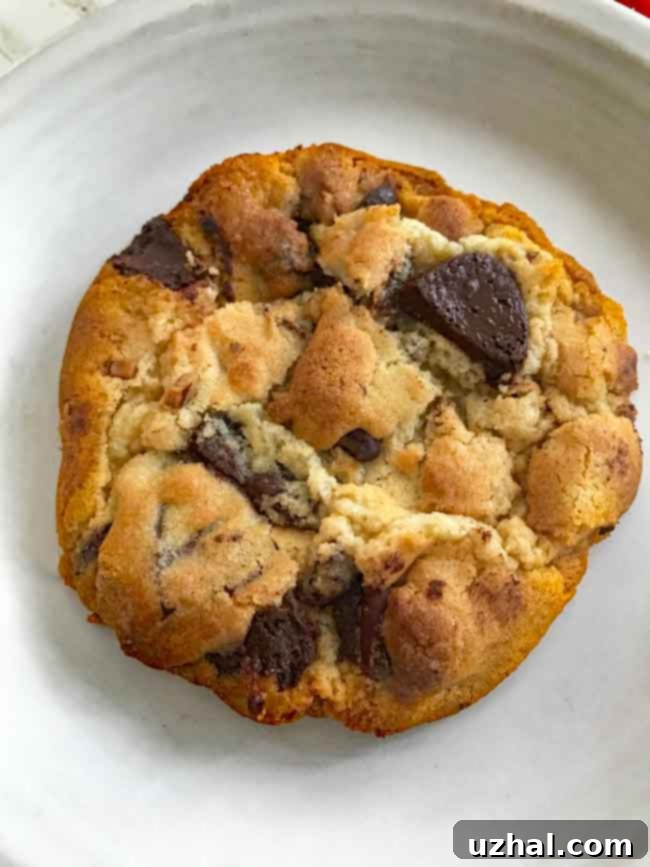Mastering the Pret A Manger Chocolate Chip Cookie Copycat: The Ultimate Guide to UK Self-Raising Flour & American Substitutes
There’s an undeniable magic to the Pret A Manger chocolate chip cookie. Its perfectly chewy interior, slightly crisp edges, and generous pockets of melted chocolate have captivated countless dessert lovers worldwide. For years, this beloved bakery treat has been a source of fascination for home bakers, leading to a surge in copycat recipes attempting to capture its unique charm. My journey to recreate this iconic cookie began some time ago, armed with a recipe purportedly shared by Pret A Manger itself during a period when everyone was eager to replicate their favorites at home. This quest for the perfect replica has been a delicious and educational experience, highlighting the nuances of baking that often go unnoticed.
The allure of the Pret A Manger cookie recently became even stronger for my family when my daughter visited London. While there, she made sure to snap a picture of the authentic cookies, freshly baked and glistening, providing a real-life benchmark for my own baking endeavors. Seeing those genuine cookies reconfirmed the standard I was striving for – a true bakery-quality experience. Below, you can see what these delightful originals look like, a visual reminder of the goal.

My experiments with this copycat recipe have revealed a crucial insight: while the core formula is robust, achieving identical results to Pret’s original is a delicate balance, particularly concerning a key ingredient – self-rising flour. The differences between UK self-raising flour and American self-rising flour are more significant than one might initially assume, and these variations dramatically impact the final texture, flavor, and appearance of the cookies. I’ve baked multiple batches using various American self-rising flour brands, and the outcomes have been noticeably inconsistent. This hands-on experience has shown that the choice of flour is not merely a preference but a critical factor in the success of this particular recipe. Here’s a look at my latest batch, baked on March 8, 2025, using White Lily self-rising flour.

To further illustrate the variations I’ve encountered, here’s an older photograph of one of my earlier attempts, showcasing a slightly different outcome. Each batch, while delicious in its own right, presented a unique set of characteristics, reinforcing the idea that baking is often a science of precise measurements and understanding ingredient interactions.

Understanding Self-Rising Flour in Chocolate Chip Cookies
Many traditional British baking recipes, including the one for Pret’s famous cookies, specifically call for “self-raising flour.” This ingredient is a staple in UK kitchens, valued for its convenience and the consistent lift it provides to baked goods. In essence, self-raising flour is a pre-mixed combination of plain (all-purpose) flour and leavening agents, typically baking powder, and sometimes a tiny pinch of salt. The critical distinction, however, lies in the composition. British self-raising flour generally contains only flour and baking powder, without added salt. This subtle difference becomes a major factor when adapting recipes across the Atlantic.
Conversely, self-rising flour available in the USA almost always includes salt in its blend. The amount of salt can vary significantly between brands, which directly impacts the flavor profile of your cookies. This inherent salt content in American self-rising flour means that if a recipe (like Pret’s) was designed for unsalted self-raising flour, adding further salt or using an American salted version can lead to an overly salty taste in the final product. Understanding this fundamental difference is the first step toward successfully recreating these cookies, ensuring a balanced flavor that doesn’t overwhelm the rich chocolate and sweet dough.

Navigating Self-Rising Flour Brand Differences and Their Impact
The lack of standardization in self-rising flour formulations across different brands, even within the same country, presents a unique challenge for bakers. Each manufacturer uses its own proprietary blend of flour, baking powder, and salt. These varying ratios mean that the performance of self-rising flour can differ significantly from one brand to another, leading to inconsistent results in your baked goods. Some brands might produce cookies that spread more, while others might yield a denser, cakier texture, all due to the slight variations in their leavening and salt content. This variability demands attention and often requires adjustments to the base recipe.
To illustrate this point, let’s look at the specific differences in some popular American self-rising flour brands and discuss their implications for our Pret A Manger copycat cookies:
- White Lily Self-Rising Flour: This southern staple is known for its fine texture and typically contains a higher amount of leavening and salt. Specifically, it includes approximately 1 ½ teaspoons of baking powder and ½ teaspoon of salt per cup. While excellent for light and tender biscuits, this higher salt and baking powder content can be problematic for a cookie recipe designed for unsalted UK flour.
- King Arthur Self-Rising Flour: Often favored for its quality, King Arthur’s blend is typically less salty. It contains about 1 ½ teaspoons of baking powder and ¼ teaspoon of salt per cup. This lower salt level makes it a potentially better choice for recipes where you want more control over the sodium content, though it still contains salt not found in UK self-raising flour.
- Pillsbury & Gold Medal Self-Rising Flour: These widely available brands tend to have salt contents closer to that of White Lily, meaning they also contribute a significant amount of sodium and leavening to your dough. Bakers using these brands should be aware of this and consider adjusting any added salt in their recipes accordingly.
My personal experience using Pret’s recipe with White Lily self-rising flour has been a testament to these differences. The resulting cookies were impressively large, measuring around 4 ½ inches wide and a little over a quarter-inch thick. They developed a wonderfully crispy exterior and an intensely chewy center – a texture that was indeed delightful. However, the downside was a distinct, slightly metallic taste from the baking powder and an undeniable saltiness that detracted from the overall indulgence. This wasn’t an issue I recalled experiencing with other self-rising flour brands in the past, leading me to conclude that White Lily, despite its excellent baking qualities for other applications, might not be the ideal choice for this specific copycat recipe if you’re aiming for an authentic Pret A Manger flavor profile. For best results, consider a brand with lower salt, or be prepared to meticulously adjust (or entirely omit) any additional salt the recipe might call for.
Achieving Well-Browned, Bakery-Style Cookies
Another crucial aspect of replicating that authentic bakery look and taste, specifically the desirable golden-brown exterior, is directly tied to the leavening agents in your flour. Traditional self-raising flour (UK style) primarily uses baking powder for lift. Baking powder is an acid-based leavener that reacts when wet and heated, producing carbon dioxide. What it often lacks, compared to baking soda (which is alkaline), is the ability to significantly boost the Maillard reaction – the chemical process responsible for browning and the development of complex savory and sweet flavors in baked goods. Since self-rising flour typically doesn’t contain baking soda, the cookies may not brown as readily or deeply as those made with recipes that include baking soda.
To compensate for this and achieve that coveted well-browned, bakery-style finish, you might need to employ a few techniques: utilizing a convection oven, which circulates hot air for more even and rapid browning; baking at a slightly higher temperature; or positioning your baking sheet on the top rack of the oven. Some bakers also find success by adding a tiny pinch of baking soda (1/4 to 1/2 teaspoon) to the dough, even when using self-rising flour, to introduce that alkalinity and promote better browning and a slightly chewier texture, but this should be done cautiously to avoid an off-flavor. The goal is a rich golden hue without over-baking the cookie’s interior.

The Original Pret A Manger Recipe in The Independent
For those interested in exploring the foundational recipe, the original Pret A Manger chocolate chip cookie recipe was notably featured in The Independent, a reputable source that shared Pret’s official guidelines during the initial wave of home baking enthusiasm. You can also often find updates and inspiration by following Pret A Manger on their official Facebook or Instagram pages. The version provided below offers an adapted recipe, including approximate volume measurements for convenience. However, it’s worth reiterating a golden rule of baking: if you have access to a kitchen scale, using the precise gram measurements from the original recipe will invariably yield the most consistent and authentic results. Baking by weight minimizes variations in flour density and other ingredients, leading to a more reliable outcome.
One of the defining characteristics of the Pret A Manger cookie is its generous amount of chocolate. This isn’t just about flavor; it’s about texture. The recipe truly demands a substantial quantity of high-quality chocolate to achieve those signature molten pockets throughout the cookie. If you’re fortunate enough to have premium ingredients like Valrhona disks or chocolate fèves, this recipe provides an excellent opportunity to utilize them. These types of chocolate are specifically designed to melt beautifully and spread into luxurious puddles within the cookie dough, creating that irresistible visual and textural appeal. If those aren’t readily available, high-quality large chocolate chunks or Guittard Super Chocolate Chips also perform exceptionally well, delivering a rich, satisfying chocolate experience that is central to the Pret A Manger cookie’s allure.
Exploring Similar Cookies Without Self-Rising Flour
While this article focuses on recreating the Pret A Manger cookie with self-rising flour, it’s entirely understandable if you’d prefer to avoid the complexities and inconsistencies associated with different self-rising flour brands. For bakers seeking a similar sweet, chewy, and satisfying chocolate chip cookie experience but without the specific characteristics of self-rising flour, there are fantastic alternatives. Eliminating self-rising flour gives you complete control over the leavening agents (baking powder and baking soda) and salt content, allowing for a more predictable and customizable outcome.
For instance, my recipe for Big Flat Chocolate Chunk Cookies offers a wonderfully chewy texture and sweet flavor profile, without any residual baking powder taste. While these cookies tend to be a little flatter than Pret’s signature puffed-up creations, they deliver an equally delightful indulgence, proving that you can achieve exceptional results by building your cookie from scratch with all-purpose flour and controlled leavening. This approach allows you to tailor the flavor and texture precisely to your liking, overcoming the challenges posed by pre-mixed flours.
For more baking inspiration and to explore other recipes that thoughtfully incorporate or substitute self-rising flour, check out these related articles:
- Self Rising Flour Banana Bread
- Recipes with Self-Rising Flour
- How to Make Self-Rising Flour and Cake Flour
- Easy Chocolate Muffins with Self-Rising Flour
- Self-Rising Flour Chocolate Chip Cookies
Recipe: Pret A Manger Chocolate Chip Cookie Copycat

Pret a Manger Chocolate Chip Cookie Copycat
Anna
Pin Recipe
Ingredients
- 110 grams unsalted butter (softened)
- 170 grams granulated sugar (¾ cup plus 2 scant tablespoons)
- 85 grams light brown sugar (¼ cup plus 2 tablespoons tightly packed)
- 1 large egg
- 190 grams self-raising flour from the UK (or American self-rising flour, approximately 1 ½ cups; adjust salt accordingly)
- 3 grams salt (½ scant teaspoon, or omit entirely if using American self-rising flour)
- 120 grams large chocolate buttons or chunks (Use your favorite dark, semisweet, or bittersweet chocolate for optimal melting and flavor)
Instructions
-
Begin by preheating your oven to 360°F (180°C). A slightly lower temperature of 350°F (175°C) is also acceptable. For best results in achieving even baking and a lovely golden-brown finish, a convection oven is highly recommended if available.
-
Ensure your butter is properly softened – it should be extremely squishy to the touch but not at all melted or oily. In a large mixing bowl, using an electric mixer on low speed (or by hand with a sturdy whisk), cream together the softened butter, granulated sugar, and light brown sugar until the mixture is light, fluffy, and creamy in texture. This step incorporates air, contributing to the cookie’s texture.
-
Reduce the mixer speed to low, then beat in the large egg until it is fully incorporated into the sugar-butter mixture. Once combined, gradually add the self-raising (or self-rising) flour and stir just until no dry streaks of flour remain. Be careful not to overmix, as this can develop the gluten too much, leading to tougher cookies. Finally, gently fold in your chosen chocolate pieces until they are evenly distributed throughout the dough.
-
Divide the cookie dough into 8 equal portions. These will be substantial cookies, characteristic of the Pret A Manger style.
-
Arrange the dough mounds onto an ungreased baking sheet or one lined with parchment paper. Lightly press down on each mound to slightly flatten them, encouraging a wider spread during baking. Bake in the preheated oven for approximately 15 to 17 minutes, or until the cookies are gloriously golden-brown around the edges and visibly puffed up in the center. Baking times can vary, so keep a close eye on them.
-
Once baked, remove the baking sheet from the oven and allow the cookies to cool directly on the pan for about 30 minutes. This crucial cooling period allows the cookies to set properly, preventing them from falling apart when transferred and contributing to their ultimate chewy texture. After cooling on the pan, transfer them to a wire rack to cool completely if desired, though they are often best enjoyed warm!
